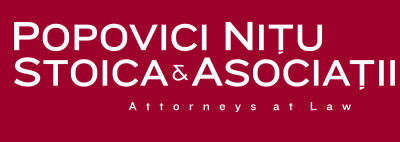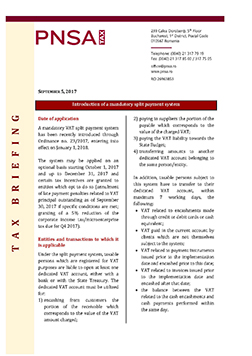- About Us
-
Expertise
- Banking & Finance
- Capital Markets
- Competition & Antitrust
- Corporate & Commercial
- Data Privacy
- Employment & Pensions
- Energy & Natural Resources
- Gambling & Betting
- Healthcare & Pharmaceuticals
- Insurance
- Intellectual Property
- International Arbitration
- Litigation
- Mergers & Acquisitions
- Project Finance/PPP, Concessions & Infrastructure
- Public Procurement
- Real Estate
- Restructuring & Insolvency
- Sports Law
- Tax
- Telecommunications, Media & Technology
- Transports & Logistics
- White Collar Compliance & Defense
- Our team
- Careers
- Publications
- News and Press
- Contact
Legal Update
Introduction of a mandatory VAT split payment system
Tax Briefing
Date of application
A mandatory VAT split payment system has been recently introduced through Ordinance no. 23/2017, entering into effect on January 1, 2018.
The system may be applied on an optional basis starting October 1, 2017 and up to December 31, 2017 and certain tax incentives are granted to entities which opt to do so (annulment of late payment penalties related to VAT principal outstanding as of September 30, 2017 if specific conditions are met; granting of a 5% reduction of the corporate income tax/micro-enterprise tax due for Q4 2017).
Entities and transactions to which it is applicable
Under the split payment system, taxable persons which are registered for VAT purposes are liable to open at least one dedicated VAT account, either with a bank or with the State Treasury. The dedicated VAT account must be utilized for:
- encashing from customers the portion of the receivable which corresponds to the value of the VAT amount charged;
- paying to suppliers the portion of the payable which corresponds to the value of the charged VAT;
- paying the VAT liability towards the State Budget;
- transferring amounts to another dedicated VAT account belonging to the same person/entity.
In addition, taxable persons subject to this system have to transfer to their dedicated VAT account, within maximum 7 working days, the following:
- VAT related to encashments made through credit or debit cards or cash equivalent;
- VAT paid in the current account by clients which are not themselves subject to the system;
- VAT related to payment instruments issued prior to the implementation date and encashed prior to this date;
- VAT related to invoices issued prior to the implementation date and encashed after that date;
- the balance between the VAT related to the cash encashments and cash payments performed within the same day.
Partial payments must be allocated proportionally between the taxable base and the related VAT. If encashment relates to transactions which were subject to different VAT regimes and/or rates, the allocation should be made with priority towards VAT-able transactions, starting with the higher VAT rate transactions and decreasing accordingly.
Transfers from the VAT account (for destinations other that those mentioned above) is possible only towards bank accounts opened with the same credit institution and only further to the approval of the tax authorities. Requests addressed to tax authorities should be settled within 3 working days, but the related procedure detailing the competent authority, required documents and conditions is not yet issued.
Amounts to be received further to VAT reimbursement requests are to be made directly to the current account, unless the taxable person instructs otherwise.
Special provisions exist with respect to assignment of receivables as well as escrow payments.
Exclusions
The split payment system is not applicable for:
- deliveries which are subject to the reverse-charge mechanism (i.e. VAT is not invoiced by the supplier, but assessed by the beneficiary under the reverse-charge mechanism);
- deliveries and supplies which are subject to special regimes (i.e. (i) small enterprises exemption regime; (ii) tour operators’ margin scheme; (iii) special regime for second hand goods, art goods, collectibles and antiques; (iv) special regime for investment gold; (v) special regime for electronic and telecom services and (vi) special regime for agriculture);
- acquisitions performed by individuals which are taxable persons but are not registered and do not have the liability to register for VAT purposes (no liabilities lay with the payer, but the entity encashing such amounts has to transfer the encashed amounts which correspond to the levied VAT in the dedicated VAT account);
- payments performed in cash or by credit/debit cards (no liabilities lay with the payer, but the entity encashing such amounts has to transfer the encashed amounts which correspond to the levied VAT in the dedicated VAT account).
Opening of accounts
The dedicated VAT accounts shall contain the letters “VAT” as part of their IBAN in order to allow for an easy identification.
Banks may (but are not required to) open accounts for their clients automatically. In case accounts are opened automatically:
- banks are required to notify their clients on the opening of the accounts, the terms and conditions as well as on the related costs;
- clients may opt for keeping the account or request its closing, within a 90 days timeframe. In case no option is received in 90 days or the client has requested the closing of the account, no charges would be levied by the bank (on the condition that no transactions have been carried out through this account).
The Treasury will also automatically open dedicated VAT accounts for all taxable persons which are registered for VAT purposes and the list thereof will be made public (either on the website of the tax authorities or that of the Ministry of Finance). Such accounts may begin to be utilized by their only upon presenting the general documentation requested for the opening of accounts. Treasury accounts will have no commissions but would bear no interest.
Fines
Fines are applied for contraventions like:
- making payments related to VAT in other accounts than the dedicated VAT account of the supplier, in case such payments are not corrected within 7 working days:
- 0.06%/day from the amount erroneously paid, starting with the day when the erroneous payment has been performed and until its correction (but no more than 30 days from the date of the erroneous payment);
- 50% of the VAT amount erroneously paid, after the above-mentioned 30 days have elapsed.
- making payments related to VAT out of other accounts than the dedicated VAT account (save for the mentioned exceptions) as well as non-observing the liability to transfer certain encashed amounts into the dedicated VAT account within the 7-working day period:
- 0.06%/day from the amount erroneously paid (or not duly transferred into the VAT dedicated account), starting with the day when the payment has been performed and until its correction (but no more than 30 days from the date of the erroneous payment);
- 50% of the VAT amount erroneously paid out of another account (or not duly transferred into the VAT dedicated account), after the above-mentioned 30 days have elapsed.
- not informing clients and suppliers on one’s own VAT dedicated account: RON 2,000 – 4,000.
Steps forward
In the limited amount of time until the VAT split payment system becomes mandatory, companies should:
- determine the changes necessary in their accounting/ERP systems, in light of their actual activity, in order to:
- set up the information related to clients’ and suppliers’ dedicated VAT accounts;
- enable the identification of erroneous payments and encashments, as well as identifying amounts which should be transferred by the company in its own dedicated accounts (including performing the allotment for partial payments as well as payments related to multiple VAT rate supplies);
- implement the necessary changes in the accounting/ERP systems;
- contact the bank/Treasury in order to ensure that the necessary formalities are fulfilled in order to have at least one operational VAT dedicated account on January 1, 2018;
- determine changes necessary in internal payment and check procedures in order to ensure compliance;
- train personnel on additional checks and tasks to be performed;
- communicate with clients and suppliers in order to ensure that the necessary information on the VAT dedicated amounts is exchanged. In cases when the supplier dedicated account could not be obtained, the public listing of the dedicated accounts automatically issued by the Treasury should be interrogated (once available);
- adjust cash-flow projections to reflect (i) client receivables no longer available for general use (for the portion corresponding to VAT); (ii) own liquidities which are going to be blocked for covering temporary shortages in the own VAT dedicated account until release further to the tax authorities’ approval; (iii) additional payments related to accounting system/ERP adjustments, supplementary bank commissions as well as other costs connected to implementing and running the system. Depending on outcome, seek and obtain other sources of finance.
The report hereto has a strictly informative, selective character; it does not represent legal advice, not treats a specific matter in all its aspects. This report is protected under the regulations pertaining to the copyright and it cannot be reproduced without the prior consent of PNSA TAX.
For supplementary information or analysis on specific matters, please contact Alexandru Ambrozie, Mihaela Pohaci or Raluca Rusu.
Download Document











